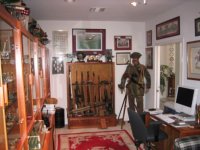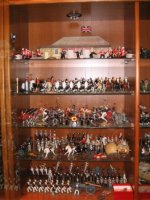Hi Jack,
Did Waynepoo "consumer-test" his theory?

j/k...

I'm not so much concerned with what the precise parameters of the problem are, as I am with being safe. A scratch that induces failure in one piece of glass might not destroy another piece, because "all tempered glass is not created equal."
Just now, I tried to find some explanation of what I suggested in my post above. However, most of it's written in language that transcends most of our ability to digest it. With that limitation in mind, here's a blurb from Wikipedia regarding the subject:
A video illustrating such an event:
[video=youtube;xPwaq_6aXbo]http://www.youtube.com/watch?feature=player_embedded&v=xPwaq_6aXbo[/video]
A reasonable response to the video is, "what moron is going to hit his shelf with a hammer?" Well, my concern is that a TS that falls a foot onto a lower shelf might have some of the same effect. BTW, I'm much more concerned about TS than models because the specific gravity of a metal soldier is so much greater than that of a diecast model, focusing the force of impact in more of a hammer-like fashion. Another cause for concern is a phenomena associated with tempered glass known as "spontaneous failure," which occurs when the material appears to fail for no reason. However, my reading indicates that the failure is really not spontaneous at all. Rather, it's associated with damage to the glass which occurred hours, days or months before (years, perhaps). Factors which introduce variability into failure are quality, thickness, total surface area, load and damage. Damage is more likely to induce failure when it occurs at the edges or center of the material.
Finally, I know someone who experienced just such a failure. It was of the "spontaneous" variety and occurred in an Ikea display cabinet containing some diecast model airplanes, a load well under the stated "safety" limit of 25 pounds. The shelf that failed collapsed onto a lower shelf, which withstood the impact, but the models were hash. A shelf and models below that level were undamaged. Ikea doesn't warranty its shelving against damaged contents, BTW. It's my understanding that no tempered glass sold in the USA does either. Because the quality of the glass is a central issue, I'd be deeply concerned about buying material of Chinese manufacture. What can we do to limit the possibility of such a catastrophe? Find the best possibile combination of thickness and quality that you can, and go with it. Even that wasn't enough for me, so I added a rider to my collectibles policy which insures against such an event.
Thoughts?
 . Hopefully, I will not damage them when I put them back in. I would hate to remove the figures from my Little Legion, Trophy or Britains cabinets. It took a lot longer than I thought it would. I did not box them up but put them on the bar and on tables in the basement. Not boxing them up saved some time
. Hopefully, I will not damage them when I put them back in. I would hate to remove the figures from my Little Legion, Trophy or Britains cabinets. It took a lot longer than I thought it would. I did not box them up but put them on the bar and on tables in the basement. Not boxing them up saved some time



